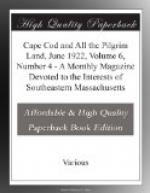“Cod and haddock, boned and white,
A drying on their flakes,
There’s none can beat the cod fish
balls
That mother only makes.
And clams and quahogs, scallops, too,
A layin’ close at hand
A waitin’ and a longin’
To be dug from out the sand.”
“My word, Edna, you make my mouth water!
“On page 11 you say that no Canadian lynx or wild cat has been seen on the Cape for 100 years. Make it about 50 years instead, because there was a catamount in South Yarmouth woods in 1867 and I think I saw it—and I could prove it if George Thatcher was alive and had his memory with him.
“How I would enjoy being out in a cat boat off Hyannis, or Dennisport, or North Dennis. Say! if the bluefish haven’t been all caught by the time I get there I will certainly try my luck. I would rather catch rock cod, or perch, or tautog, than fill a creel with brook trout, under any conditions, any day in the year; but then you don’t care, and I don’t care if you don’t—but I do.”
Yours truly,
John N. Baxter.
A MILLION QUARTS OF STRAWBERRIES
Cape Cod strawberries are destined to become as famous as her cranberries, her fishing, and her renown as a summer resort. One million quarts of them left her fields the past season! And the industry is still growing!
Cape Cod leads New England in the magnitude of this industry and Falmouth holds the honor of being the home of the Cape Cod strawberry.
There are in Falmouth something over two hundred acres in strawberries, and these acres extend over an area of between six and seven square miles. The berries for the most part are grown on land cleared from woods within the past fifteen years. New land is being cleared each season and the territory is becoming more and more extensive, the industry expanding and Falmouth as a specialized farming center more and more prominent.
The sturdy pioneers of this industry in Falmouth are Portuguese people who drifted to the section from nearby industrial centers like New Bedford and Fall River and who later persuaded their friends and relatives from across the sea to join them in this land of plenty. They are splendid people, hard working, thrifty and industrious, and make most excellent citizens. Although but few have had the opportunity to attend school, they are most intelligent farmers, ready and willing to adopt methods that will financially improve their business. The majority are, however, limited in land area and many times are obliged to crop their small farms to excess, for strawberries are the main cash crop, and very few who have more recently come here have the necessary funds to acquire much land or equipment. The acreage in berries will vary from one-half an acre to four acres. Cultural methods are practically all hand work. The land is cleared by hand, plants set and runners placed by hand, fertilizer applied by hand, hand hoed, hand weeded and naturally hand picked.




